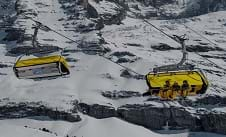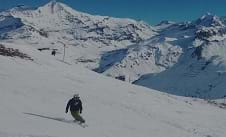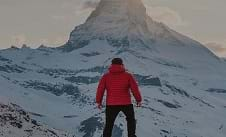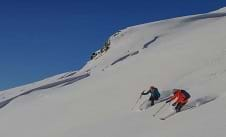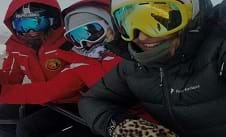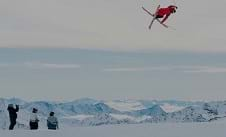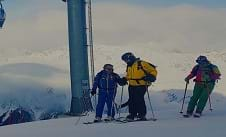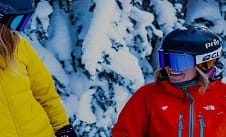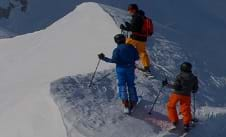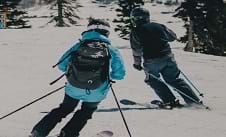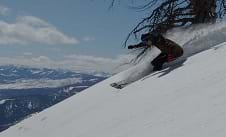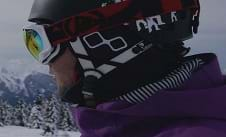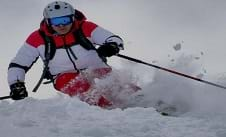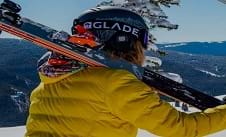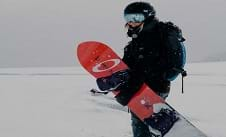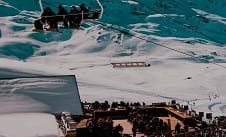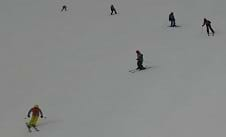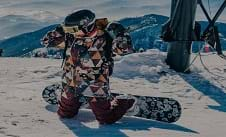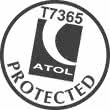Ski goggles guide
Goggles are an essential aspect of your snow kit so you should know what to look for when buying an expensive piece of equipment. If you were the wrong lens or the goggle's fit isn't suitable, it can ruin your day on the slopes. Common problems can be the change in weather conditions - it's bright and sunny in the morning, so you take your lenses with a dark tint. Then in the afternoon, it turns cloudy, and you can barely make out the contours in the snow in the flat light. Problems like this can now be avoided with the fantastic tech available.
Luckily, there are many goggles available for all different budgets, styles and requirements, so we've taken a look at some of the key areas to help you work out which goggles you require. We recommend trying different goggles before you buy. You'll get a true feeling for the fit, and most ski shops will be happy to answer any questions you have.
with your own travel concierge. Don’t hesitate to drop us a line – we’ll
help plan your perfect Ski Holidays.
020 7770 6888 ← online or call ↴
020 7770 6888
Lens type/shape
Lens shapes fall into two main categories:
Cylindrical
Curved on the vertical axis inline with the natural contours of the wearers head. They typically are a lower profile with good flexibility, so changing lenses is quite simple. These lenses are usually cheaper than spherical lenses, but your periphery vision is reduced with this style.
Spherical
Curved on the vertical and the horizontal axis, creating a bubble shape, similar to the human eye. As a result, you’ll get a wider field of vision and less fogging.
Lens category & tints
The lens category and colour tint are much more than just cosmetic. Different types of lenses match the weather and light conditions to allow you to see the lumps and bumps on the slope easier. VLT, Visible Light Transmission, is the amount of light a goggle lens allows to pass through. Different lens colours and constructions are designed to allow varying levels of visible light through to the eye, which alters the lens's properties.
VLT comes in categories based on the percentage of visible light they let in. Here’s a general overview:
- CAT 0: Large light access (approx. 80% +)
- CAT 1: Good for low light or inclement conditions like fog (80% - 43% visible light approx.)
- CAT 2: Best suited to overcast/cloudy conditions (43% -18% visible light approx.)
- CAT 3: For sunny days (between 18% and 8% visible light approx.)
- CAT 4: Minimal light access (approx. 8% & under).
CAT 0 and CAT 5 are opposite, extreme ends of the spectrum and you’ll find most lenses within CAT 1, 2 & 3.
The lens colour comes into play too as different shades or tints alter the filtering properties. For example, you'll find bronze/amber as the base colour of most all-around goggles because the good shadow contrast works well in bright and cloudy conditions.
Some photochromatic lenses will cover a range of categories by varying the tint depending on the light conditions. Double lenses or polarization can be used to enhance performance and prevent fogging or reflecting glare. Most big manufacturers like Oakley and Dragon have proprietary technology, which we cover below.
Lens technology
Like any important piece of sports equipment, lens technology is ever-changing and continually innovating. Features that you'll find on ski goggles are:
- UV protection - UVA and UVB protection is a necessity with the intense light conditions on the mountain. Look for 100% protection where possible and avoid Photokeratitis or worse.
- Mirrored lenses - Helps reduce glare from light reflected off the snow.
- Polarised lenses - More effective glare reduction than mirrored lenses, resulting in great clarity.
- Double lenses - 2 layers of lenses separated by a seal (like double glazing) retain heat to prevent fogging.
- Anti-Fog - A hydrophilic coating helps prevent moisture build-up (often requires upkeep/treatments to maintain performance)
Other features are brand specific. These are popular ones you’ll come across:
- Oakley Prizm - Strategic colour filtering and enhancement (particularly red and cyan). Helps highlight changes in topography.
- Dragon Lumalens - Designed for depth perception, vivid colour and enhanced contrast.
- Smith ChromaPop - By filtering out certain wavelengths of light, colours are more defined, leading to greater clarity.
- Giro Vivid Tech - Manipulates blue light filtering for improved contrast and visual acuity.
- POC Clarity - Developed in conjunction with Carl Zeiss, specific peaks in the colour spectrum are filtered to enhance vision.
Goggle frame size
Goggle fit is vital in creating a good seal, maintaining a good field of vision and being comfortable. This depends on your face shape and head size, so companies make various sizes and specialities of their ski goggles. Not all brands will go into this detail, but you can expect to find these sizes for goggles:
- Extra small/small frames - Best suited to children and smaller than averages faces.
- Small/Medium - Ideal for older children and adults with smaller faces
- Medium - A good fit for most adults
- Medium/Large - Slightly larger than the medium for those that need a bit more space.
- Large - Bigger fits for the largest faces and those looking for an ‘oversized’ goggle style.
- Over the glasses - Deeper, larger volume goggles designed to cover your glasses.
Signs that you might need to change your goggles fit:
- Pressure on the outside of the face or temple = try loosening the strap but your goggles may be too narrow.
- Pressure on the nose = the goggles may be sitting low, so try tightening them or trying a frame with a different bridge shape.
- A gap on the nose = Try loosening your strap or a different, likely larger, bridge shape.
Other goggle features
Interchangeable Lenses
Removable lenses let you take a spare with you that you can swap on the fly in response to changing weather/light conditions. Having a flat light/low light condition lens and a brighter light lens should keep you covered most days. These lenses can be ‘clipped in’ to the frame, but loads of other technologies like Anons MIG that attach the lens by magnet make changes easier in cold conditions or wearing gloves.
Foam
Foam sits between the face and frame providing comfort, insulation and preventing ice/grit from entering through the vents.
Strap
All goggles have an adjustable strap to tailor the fit around your head and relieve pressure. Usually, these are fabric with rubber grippers to prevent slippage. The strap will either go around your head or your helmet.
Helmet Compatibility/Integration:
Some goggles are designed to work with helmets specifically. The strap will be long enough to fit around the helmet (helmets usually have a clip to help anchor the strap). Plus, the goggles may be shaped to fit in line with the frame of a helmet, leaving no gap on your forehead between the helmet and goggle. This works for helmets too; some brands design the helmets to specifically fit certain models of goggles. This eliminates the ‘gaper gap’ and improves fit.
Frameless
Goggles that give the illusion that there is no or minimal frame. In reality, it’s just pared back and gives a wider field of vision which can be useful in smaller goggles.
Goggle care & tips to prevent fogging
Like any eyewear, you’ll want to treat them well, so they continue to perform and have a long life. Most have an anti-fog coating (or tech like double lenses) to keep your vision clear, but you may need to treat the lenses to maintain this. The manufacturers will have info on compatible solutions, so check the packaging or online to avoid wrecking your lens.
Similarly, scratching your lenses is a sure-fire way to ruin your view of the mountain. Don’t go pawing at them with greasy, gritty gloved fingers. Instead, use a clean microfibre cloth. You’ll usually get one with the goggles, and some even double up as a protective bag. A top tip is to keep a cloth in your salopettes pocket just if you need to use it.
Tips to avoid for longer lens life are:
- Don’t place them lens down when you take them off to avoid scratches.
- Don’t store them wet. Place under or near a heater overnight to dry out to avoid fogging the next day.
- Don’t store them in direct sunlight, especially when drying.
To help prevent fogging, try these tips:
- Shake (don’t wipe) off excess snow.
- Keep the vents clear as airflow is key to prevent fogging.
- Don’t rest them on your head as body heat will steam them up quickly.
- Dry them out between outings.
- Dab/pat clean if you absolutely need to. Don’t rub!
- Ski more as airflow is the best prevention
Ski goggles FAQ:
You can clean your outside lens with the bag the goggles come in or with a specific google cleaning cloth/wipe. It would be best to avoid cleaning the goggles' inside lens as they come with an anti-fog solution, and cleaning this side will stop the anti-fog from working.
Most ski goggles come with an anti-fog solution on the inside of the lens. However, they sometimes can still get foggy. The best way is to make sure you don't breathe on the inside of your lens as this will trap condensation. Make sure the vents on your goggles aren't covered, and air can flow through. If it's wet or snowy, you may need to stop and dry out your goggles.
The type of weather conditions affects what colour lens you should be skiing with. For low light, the best colour lens is lighter colours like yellow or orange. For bright days you want a darker coloured lens like black/dark grey. If you ski a lot, you may want two pairs of goggles or goggles with interchangeable lenses for both types of light conditions.
The technology in ski and snowboard lenses are the same. However, it's worth checking your goggles fit with your helmet, so you are protected correctly and don't look funny.
It depends on the conditions. There are different types of lenses which are more suited to low light or bright light. If you don’t want to be swapping out lenses throughout the day, then there are all-weather goggles which can handle all types of light but not as well lenses specifically designed for a certain type of light.
You can get ski goggles from many places – if you’re looking to get them cheap, you can get some great deals from Decathalon and small online UK brands. Ski resorts have many shops that will sell ski goggles once you’re there but if you want to get it sorted before you go then Snow & Rock and Elis Brigham have a great selection.






